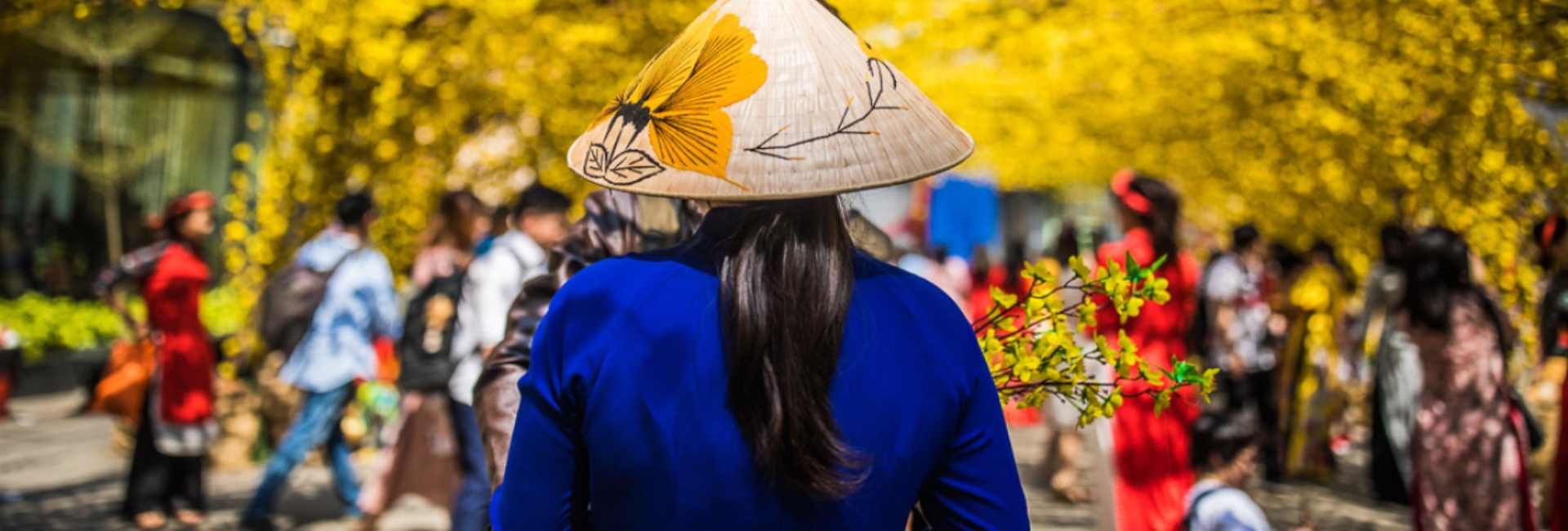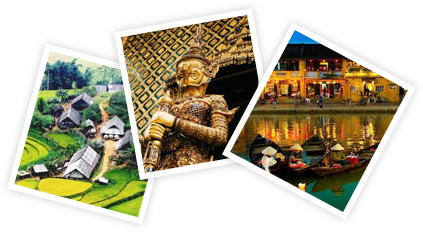Winter in Vietnam offers a unique travel experience, with diverse climates and attractions across the country. This guide will help you understand what to expect and how to plan your winter journey through this fascinating Southeast Asian nation.
When is winter in Vietnam?
Winter in Vietnam typically spans from December to February. However, due to the country’s elongated shape and varied topography, the winter experience can differ dramatically from north to south.
Winter temperatures in Vietnam generally range from 10°C to 25°C (50°F to 77°F). While these temperatures might not seem particularly cold to Western visitors, many find that winter in Vietnam feels colder than expected.
This perception is due to several factors. First, the high humidity makes the air feel cooler than the thermometer suggests. Second, most buildings lack central heating, making indoor spaces chilly. You can imagine that the winter in Vietnam will make you feel like the atmosphere and weather in London. Additionally, if you’ve spent time in Vietnam’s hot seasons, your body may be more sensitive to cooler temperatures. Coastal areas can also experience cool breezes that amplify the cold feeling.
Let’s explore winter across Vietnam’s regions:
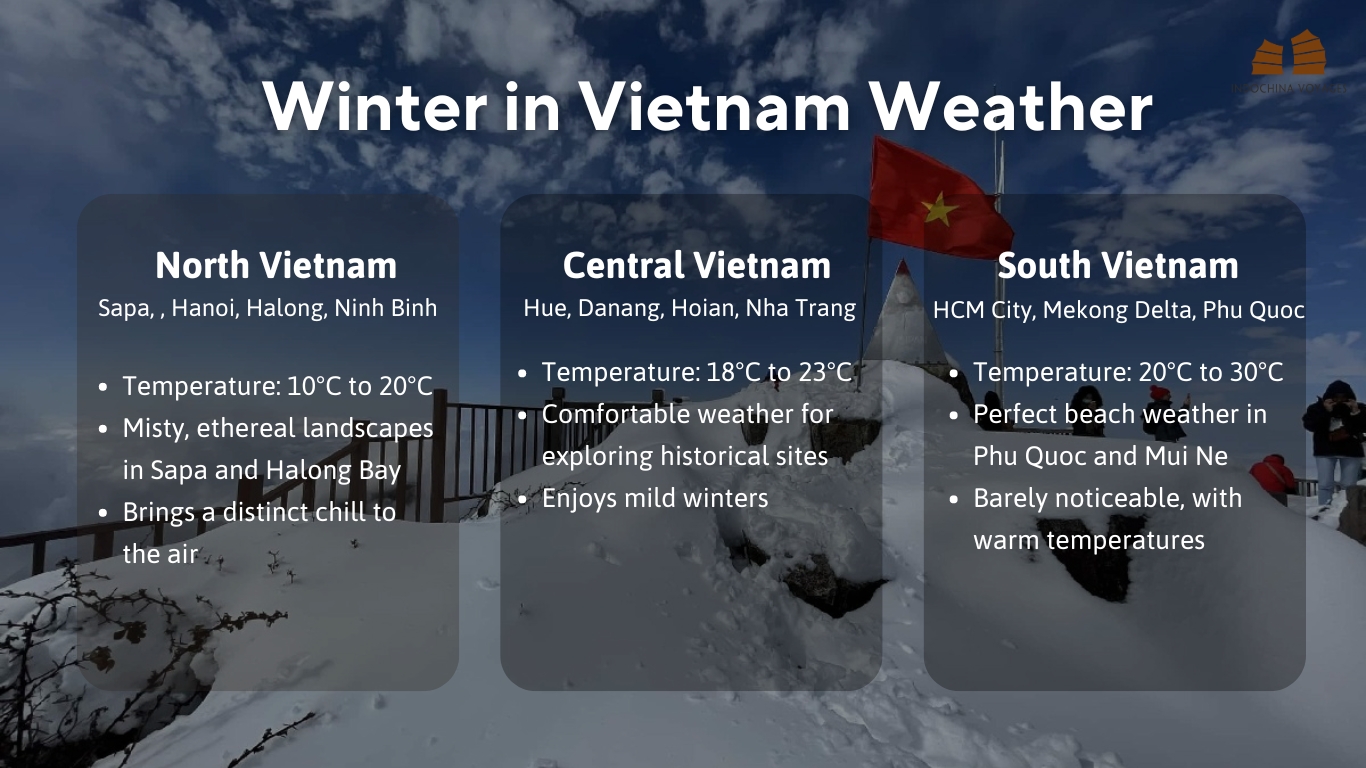
North Vietnam
- Temperature range: 10°C to 20°C (50°F to 68°F)
- Winter highlight: Misty, ethereal landscapes in Sapa and Halong Bay
In Northern Vietnam, winter brings a distinct chill to the air, especially in the evenings and early mornings. Cities like Hanoi experience cool, sometimes foggy days that create a cozy atmosphere perfect for enjoying hot bowls of pho or sipping Vietnamese coffee in quaint cafes. In mountainous areas like Sapa, temperatures can occasionally dip near freezing, offering a rare chance to see frost-covered landscapes in Southeast Asia. The iconic Halong Bay takes on a mystical quality as winter mist shrouds its limestone karsts, creating an unforgettable scenery for cruises and kayaking adventures.
Central Vietnam
- Temperature range: 18°C to 23°C (64°F to 73°F)
- Winter highlight: Comfortable weather for exploring historical sites in Hue and Hoi An
Central Vietnam enjoys mild winters, making it an ideal time to explore the region’s rich history and beautiful beaches. The imperial city of Hue and the ancient town of Hoi An are particularly pleasant during this season, with cooler temperatures perfect for wandering through historic sites and charming streets. While some days might be too cool for swimming, the beaches of Da Nang and Hoi An offer serene environments for relaxation and coastal walks. Winter also brings less rainfall compared to the autumn months, though occasional showers can occur.
South Vietnam
- Temperature range: 20°C to 30°C (68°F to 86°F)
- Winter highlight: Perfect beach weather in Phu Quoc and Mui Ne
In Southern Vietnam, winter is barely noticeable, with warm temperatures prevailing throughout the season. Ho Chi Minh City remains balmy, ideal for exploring its bustling streets, markets, and historical sites without the intense heat of summer. The Mekong Delta experiences perfect weather for river cruises and visits to floating markets. Beach destinations like Phu Quoc and Mui Ne shine during this time, offering sunny skies, warm waters, and ideal conditions for sunbathing, water sports, and island-hopping adventures.
Is Vietnam good to visit in Winter?
Absolutely! Winter can be one of the best times to visit Vietnam, offering a pleasant climate for exploration and unique seasonal experiences.
Places worth visiting for Winter in Vietnam
Here are some top destinations to consider for your winter trip:
Sapa: Nestled in the northern mountains, Sapa transforms into a winter wonderland. Misty peaks, terraced rice fields covered in frost, and the chance of snow create a magical atmosphere. It’s perfect for trekking, experiencing local hill tribe cultures, and enjoying breathtaking mountain vistas.
Halong Bay: Winter adds an extra layer of mystery to this UNESCO World Heritage site. Cruise among the limestone karsts shrouded in mist, kayak in peaceful waters, and explore hidden caves. The cooler weather makes outdoor activities more comfortable.
Hanoi: Vietnam’s capital is particularly charming in winter. Explore historic sites like the Old Quarter and Ho Chi Minh Mausoleum without summer’s heat and humidity. Warm up with street-side bowls of steaming pho and egg coffee in cozy cafes.
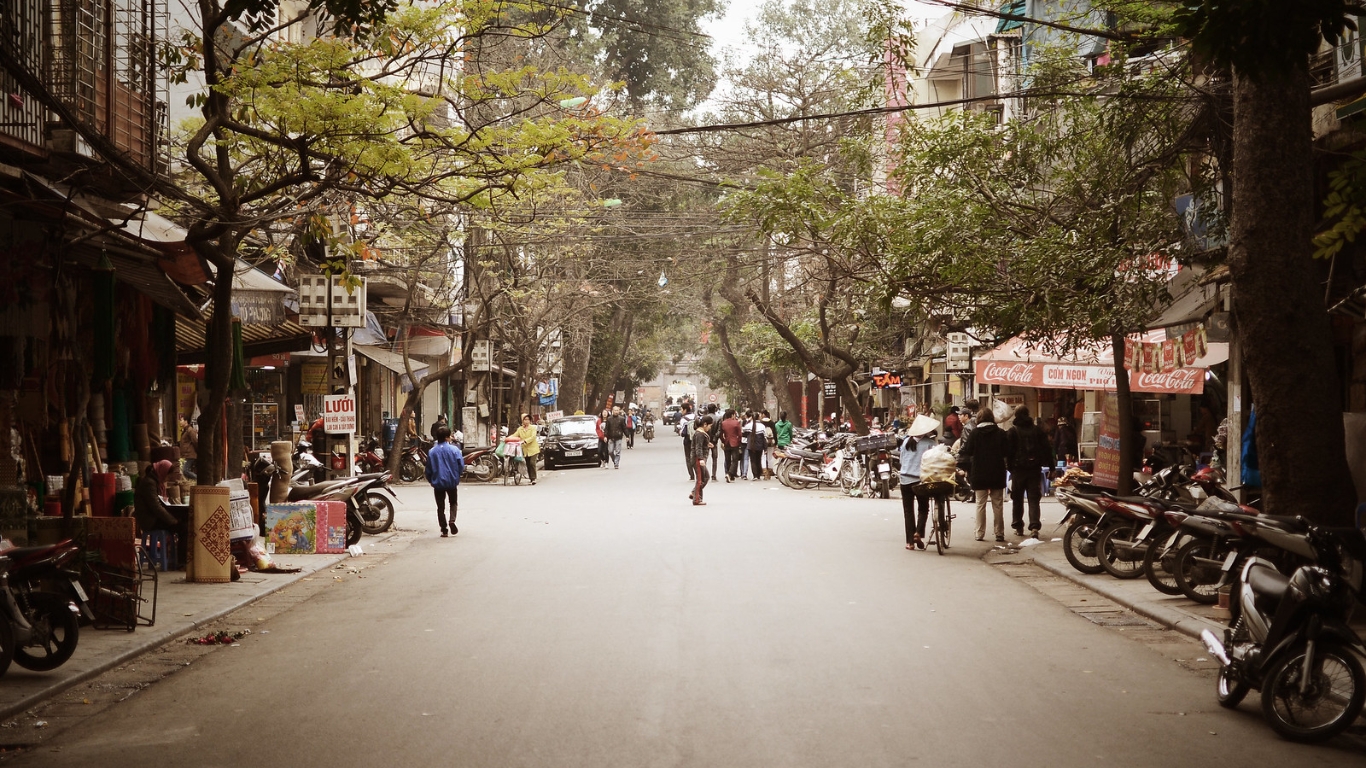
Hoi An: This ancient town is delightful year-round, but winter brings a special atmosphere. Stroll through lantern-lit streets, visit tailor shops, and enjoy the town’s famous cuisine. If you visit during Tet (Lunar New Year), you’ll experience vibrant celebrations and traditional customs.
Da Lat: Known as the “City of Eternal Spring,” Da Lat offers mild temperatures and beautiful scenery. Explore flower gardens, visit coffee plantations, and enjoy the romantic atmosphere of this highland retreat.
Phu Quoc: For those seeking warmth, this southern island is perfect in winter. Enjoy pristine beaches, snorkel in clear waters, and indulge in fresh seafood. The dry weather is ideal for exploring the island’s national park and night markets.
Mekong Delta: Winter brings comfortable temperatures for exploring the Delta’s waterways. Take boat trips through floating markets, visit fruit orchards, and experience the unique river life of this region.
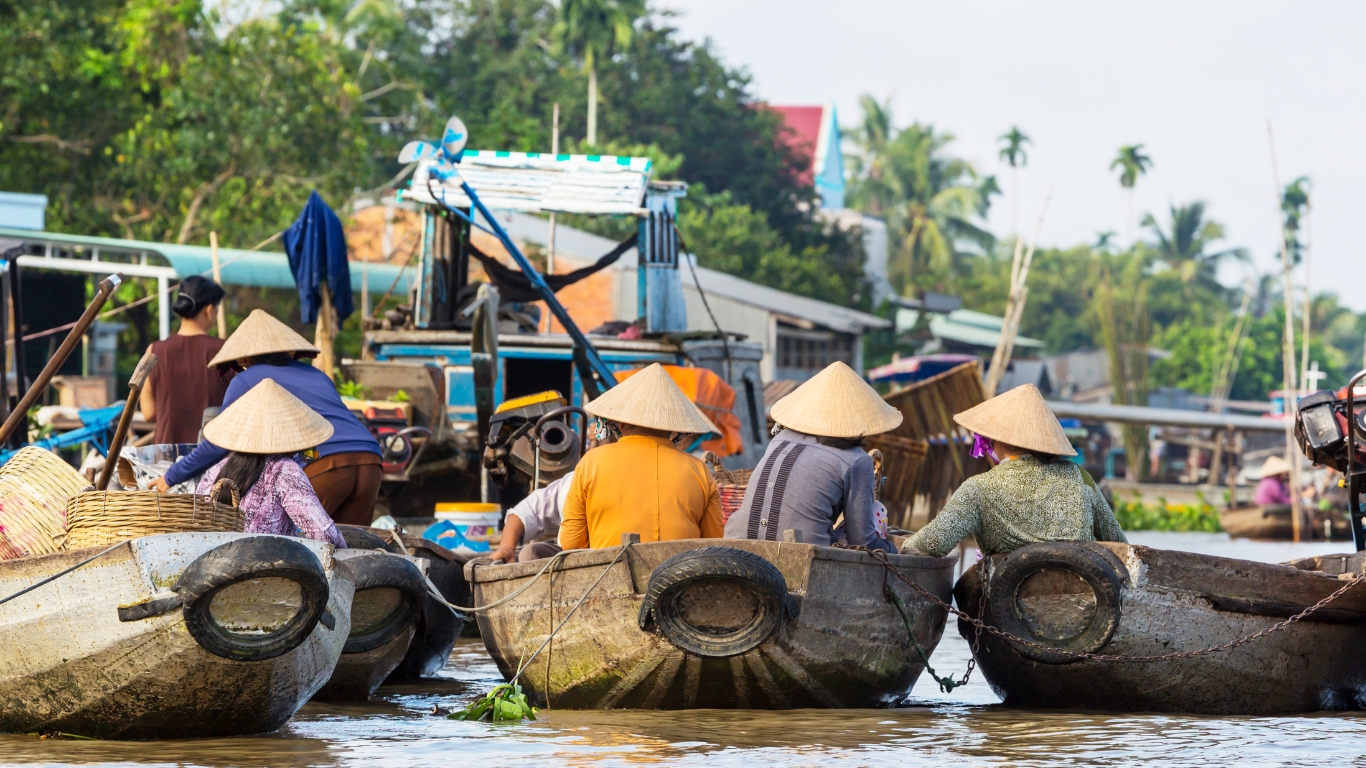
The Occasion Season in Vietnam in Winter
Besides offering a pleasant climate for exploration, winter can be one of the best times to visit Vietnam due to its unique seasonal experiences. This period coincides with several major holidays, providing special opportunities for cultural immersion and festive celebrations.
Winter in Vietnam overlaps with Christmas, New Year, and often the Lunar New Year (Tet), giving visitors a chance to experience these holidays in a unique cultural context. While Christmas isn’t a traditional Vietnamese holiday, major cities like Hanoi and Ho Chi Minh City embrace the festive spirit with decorations, special markets, and events. It’s a wonderful time to enjoy the blend of Western and Eastern traditions.
The Western New Year is celebrated throughout Vietnam, especially in urban areas and tourist destinations. You can join countdown parties, enjoy fireworks displays, and participate in local festivities.
If your visit aligns with Tet (usually in late January or early February), you’ll witness Vietnam’s most important cultural celebration. While some businesses may close, you’ll have the opportunity to experience traditional customs, special foods, and vibrant decorations. It’s a time when families come together, and as a visitor, you might be invited to join in local celebrations, offering a unique insight into Vietnamese culture.
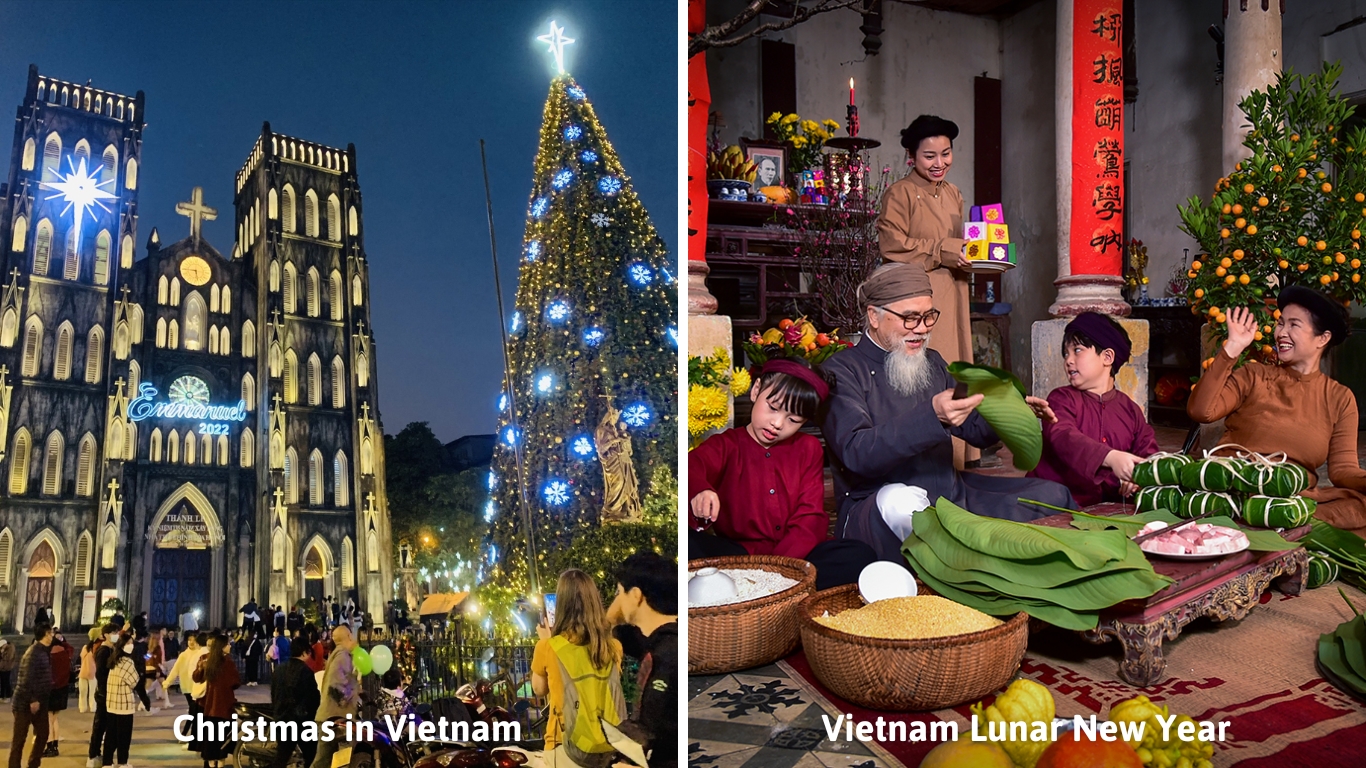
FAQs
What are the colder months in Vietnam?
December and January are typically the coldest months, especially in northern Vietnam. In Hanoi and mountainous areas, temperatures reach their lowest during this period.
What months does it snow in Vietnam?
Snow is extremely rare in Vietnam and only occurs in the highest northern mountains, such as around Sapa and Ha Giang. When it does snow, it’s usually between late December and early February. However, snow is not guaranteed and shouldn’t be a primary expectation for winter visitors.
Overall, if planning a journey to Vietnam in winter, this may offer a diverse range of experiences, from chilly mountain treks in the north to sunny beach days in the south. By understanding the regional variations and packing accordingly, you can enjoy a memorable winter journey through this beautiful and varied country. Whether you’re seeking cultural experiences, natural wonders, or simply a warm escape, Vietnam in winter has something to offer every traveler.
Thuy Dang – From Indochina Voyages Team

